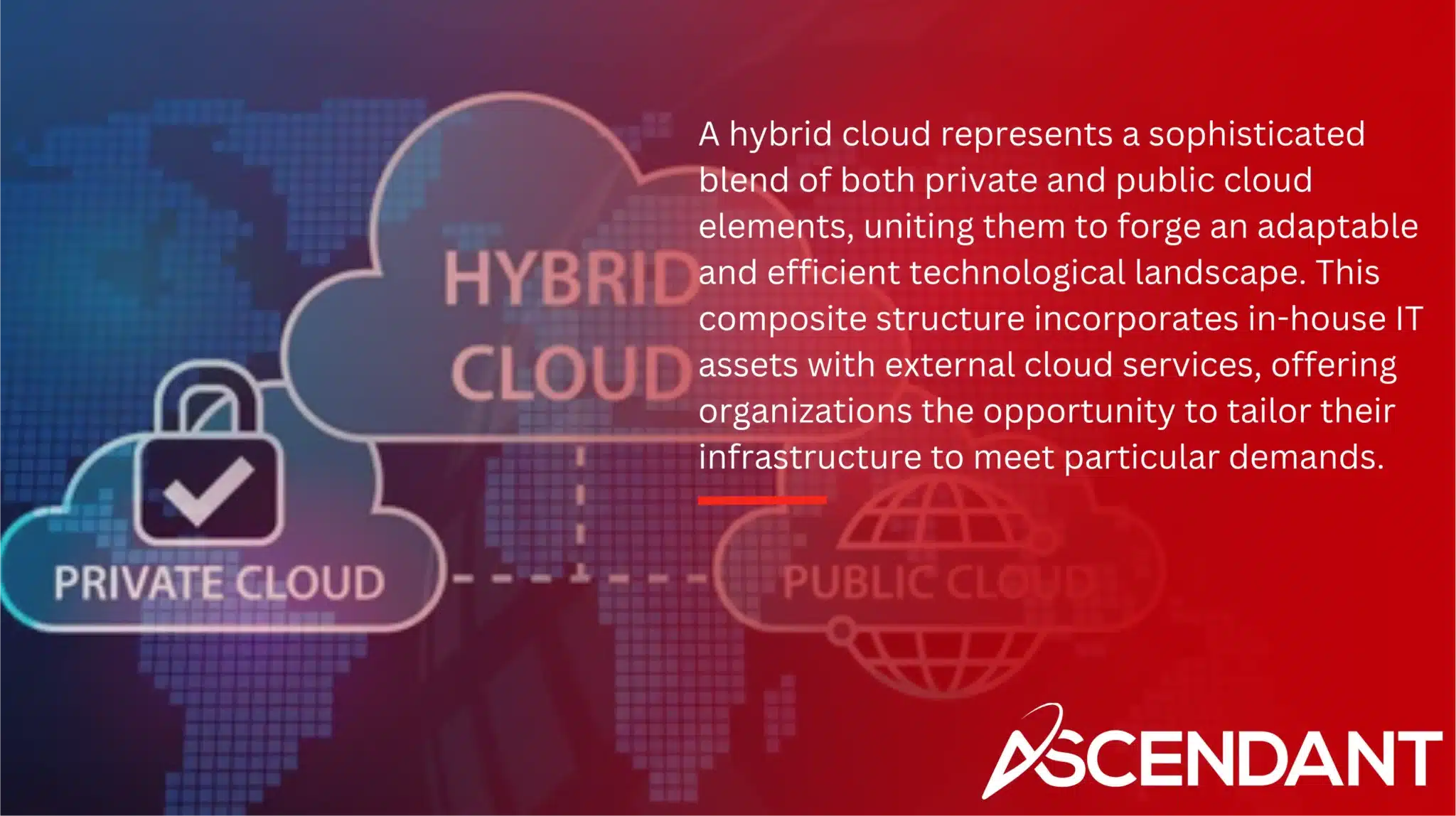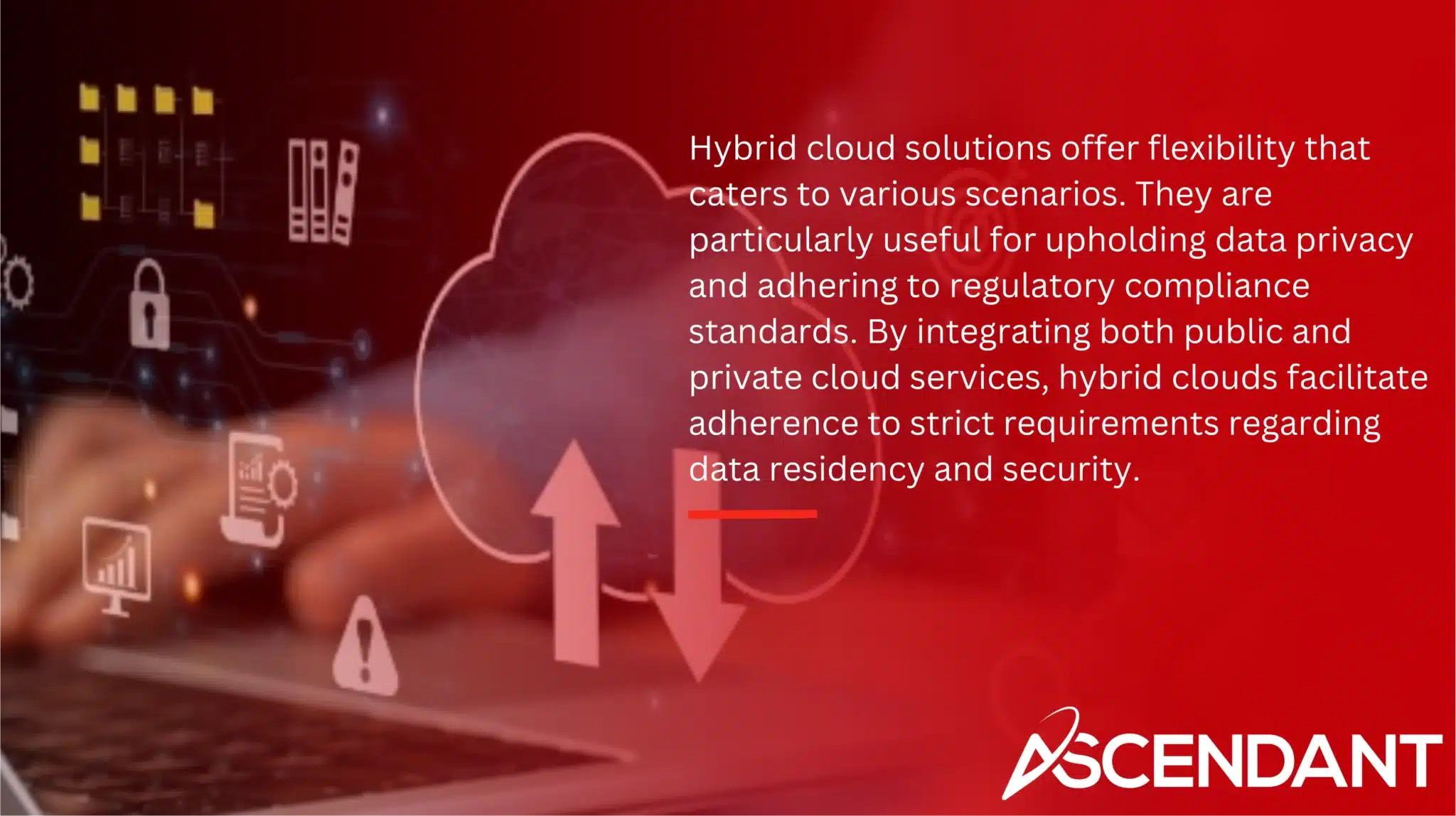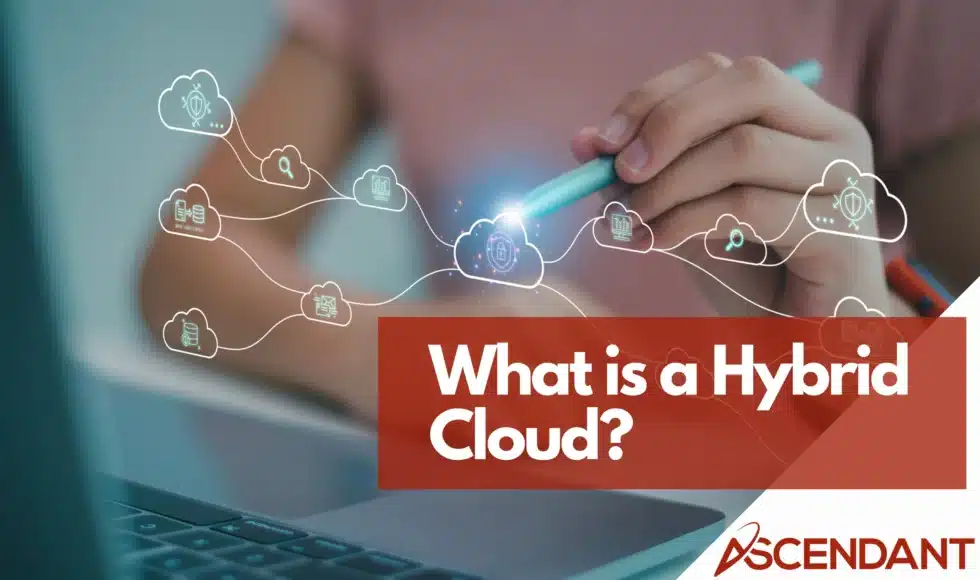Curious about what a hybrid cloud is and why it’s so important? A hybrid cloud combines private and public cloud resources to offer flexibility, scalability, and cost-efficiency. This blend allows businesses to optimize their infrastructure and adapt quickly to changing demands. In this article, we’ll explore the benefits, challenges, and components of hybrid cloud setups and how they can transform your IT strategy.
Key Takeaways
- Hybrid cloud integrates private and public cloud environments, enabling organizations to optimize resources based on specific needs and enhance operational agility.
- Key components of hybrid cloud architecture include networking, orchestration, and containerization, which facilitate effective workload management and seamless communication.
- While hybrid cloud offers scalability, cost efficiency, and improved disaster recovery, it also presents challenges such as security risks and the need for robust governance frameworks.
What is Hybrid Cloud?

A hybrid cloud represents a sophisticated blend of both private and public cloud elements, uniting them to forge an adaptable and efficient technological landscape. This composite structure incorporates in-house IT assets with external cloud services, offering organizations the opportunity to tailor their infrastructure to meet particular demands.
In various arrangements, hybrid clouds can pair up a public cloud provider with local solutions or edge computing sites such as on-site data centers. This dynamic allows companies the freedom to strategically place high-priority workloads within private clouds while leveraging public clouds for less critical tasks. By doing so, they establish an ideal mix of performance capabilities, cost efficiency and security through approaches such as hybrid cloud infrastructures, management capacities related to these hybrids, distinct models available under this paradigm including various strategies connected with managing workloads specifically designed for these mixed environments.
Hybrid cloud settings are exceedingly conducive when it comes to innovating microservices architectures and developing applications rooted in containers. These technical advantages propel organizational agility forward and heighten its reactivity towards fluctuations within the market space. Factors like requirements around low-latency operations processing information close by geographical location or compliance needs concerning where data is stored often act as catalysts encouraging businesses toward adopting practices aligned with a comprehensive strategy focused on harnessing diverse types of traditional data center resources alongside evolving possibilities offered by modern-day professionalized providers of external-cloud-based services.
How Hybrid Clouds Work
The allure of hybrid clouds stems from their sophisticated design, which hinges on adept orchestration and synchronization to harmonize data flow and resource distribution effectively. By amalgamating private and public cloud environments, they facilitate the effortless exchange of data and handling of tasks across diverse platforms.
Networking technologies such as LAN, WAN, VPNs, along with APIs, serve as the backbone for high-level interconnectivity between localized systems and broader cloud services. The agility in managing workloads grants organizations the flexibility to shift processes between private and public clouds in response to changing requirements.
Crucial too is observability within hybrid cloud infrastructures that offers a comprehensive perspective over all deployed applications. This feature underpins performance monitoring as well as event-linking activities critical for maintaining smooth operations. Specialized management tools are instrumental in regulating resources while also allowing for immediate provisioning throughout varied cloud landscapes – augmenting overall operational efficacy.
Key Components of Hybrid Cloud Architecture
The structure of a hybrid cloud infrastructure is built on several essential elements that synergize to produce an integrated computing landscape. Network components bridge the gap between private and public cloud resources, allowing for smooth communication and transfer of data. This interconnectivity aids in streamlined workload handling and shifting, which boosts both business resilience and efficiency.
In hybrid cloud environments, orchestration plays a critical role by automating the arrangement and administration of computational resources. Tools such as Kubernetes are vital for their ability to facilitate the effective deployment and oversight of applications spanning different platforms.
Containerization technologies have significantly transformed how hybrid clouds are architected. Containers guarantee uniform application delivery and functioning across various environments, promoting consistency while diminishing operational burdens. Collectively these elements constitute the fundamental framework supporting a dynamic and proficient hybrid cloud infrastructure.
Hybrid Cloud Benefits
Embracing hybrid cloud solutions can significantly boost an organization’s functionality, with scalability being a prominent advantage. By harnessing the vast and flexible resources of public cloud providers, businesses can adapt quickly to evolving demands in nearly real-time.
Hybrid clouds also offer considerable cost-saving advantages by optimizing the use of both private and public cloud infrastructures. This optimization aids in trimming IT expenses while facilitating transitions into the cloud environment. Leveraging hybrid clouds aids compliance with data residency laws and minimizes costs related to data movement for certain workloads.
Organizational nimbleness is greatly improved through the adoption of a hybrid cloud approach. Organizations gain operational flexibility as they are able to distribute applications either within on-premises environments or across various available public clouds based on their unique needs. As more diverse options for hybrid deployments emerge, this versatility underscores why enterprises find these solutions attractive today.
Common Use Cases for Hybrid Cloud

Hybrid cloud solutions offer flexibility that caters to various scenarios. They are particularly useful for upholding data privacy and adhering to regulatory compliance standards. By integrating both public and private cloud services, hybrid clouds facilitate adherence to strict requirements regarding data residency and security.
In the realm of disaster recovery, hybrid cloud environments excel by providing effective backup options and facilitating the restoration of critical data from on-premises setups into a cloud infrastructure. This dual capability is instrumental in preserving business continuity during incidents such as system outages or loss of data, offering enterprises a dependable fallback mechanism.
Organizations also utilize hybrid clouds for efficient distribution of their processing needs. Some tasks remain local while others take place within premises-based data centers. Such an arrangement proves advantageous when linking cloud-powered enterprise resource planning (ERP) systems with local inventory management applications, thereby enhancing overall operational proficiency. Through the process known as ‘cloud bursting,’ businesses can dynamically scale their resources by tapping into additional computing power from the cloud during periods of high demand without compromising performance stability.
Hybrid Cloud Challenges
Embarking on a hybrid cloud strategy brings its own unique difficulties. Security stands out as a pivotal concern, owing to the increased number of possible infiltration points that result from combining private and public clouds. Hence, maintaining uniform security practices is imperative.
Achieving comprehensive oversight over security logs is critical for adhering to compliance standards and managing governance effectively. This task can be hampered by inadequate insight into how data is accessed and stored across both public and private clouds. Data breaches in these hybrid setups are frequently due to misconfigurations like exposed ports or improper access settings.
The threat of data spilling out also looms large, often stemming from unsecured APIs or devices lacking robust protection when they link up with the cloud infrastructure. The intricacies involved in utilizing hybrid cloud solutions may cause disruptions in data streams, which necessitates highly specialized skills for proficient management.
Hybrid Cloud Security
Securing hybrid cloud environments requires an all-encompassing strategy that incorporates a variety of protective measures. To mitigate risks effectively throughout the workload, it’s important to implement and maintain enforceable security guidelines. By fusing the benefits of both private and public cloud settings, a hybrid cloud architecture offers reliable data management.
In any hybrid cloud setup, encrypting data is crucial for fortifying its defenses. This includes ensuring encryption not only for stored information, but also during data transmission as well as within operating system elements, thus blocking unsanctioned access attempts. To this protection, several firewall layers are essential in shielding databases, applications, and various parts of the operating system specific to the structure of a hybrid cloud.
The uniform enforcement of security policies via centralized management plays a pivotal role by enabling automatic application of these defenses across different workloads — leading to uniformly strong safeguarding mechanisms. Adopting a zero-trust approach is fundamental when dealing with vendors. It significantly strengthens the defense capabilities within public and hybrid clouds alike.
Best Practices for Hybrid Cloud Adoption
Implementing hybrid cloud solutions effectively requires adherence to the industry’s best practices for optimal management and efficiency enhancement. Establishing a governance framework after transitioning is vital for proficient handling of the hybrid setup. Hybrid clouds present complex compliance issues due to various providers’ distinct governance models, necessitating consistent audits to maintain adherence with standards such as GDPR and HIPAA.
It’s important that applications are positioned in environments that suit their needs by understanding specific performance and security requirements, thus prioritizing compatibility amongst multiple cloud services for streamlined integration of data and programs. Routine assessment of expenditures related to cloud usage coupled with adjustments in pricing strategies can assist organizations in steering clear of unforeseen expenses.
Creating a detailed strategy for employing a combination of resources from both public and private clouds forms the cornerstone of an effective hybrid cloud approach. This plan must encompass operational aspects including but not limited AIOps and DevOps functions which are critical in maintaining round-the-clock operations as well as competent service administration.
Future Trends in Hybrid Cloud
The prospects for hybrid cloud environments are exceedingly promising, with new trends and technologies poised to reshape the existing framework. By integrating edge computing, which facilitates on-site data processing at various locations, these environments significantly boost their capacity for real-time data analysis — ensuring that information is processed both swiftly and proximate to where it’s ultimately needed.
Artificial Intelligence (AI) plays a pivotal role in bolstering network defenses by meticulously scrutinizing patterns of data movement to unearth potential security hazards. As AI becomes increasingly integrated within hybrid cloud frameworks, its contribution towards enhancing both security measures and operational effectiveness is expected to rise.
Meanwhile, serverless architectures are becoming more prevalent due largely to their ability to scale dynamically and offer greater adaptability. They enable developers to concentrate solely on rolling out code rather than concerning themselves with the maintenance of the base infrastructure. As hybrid clouds extend geographically, allowing application deployment closer to where users reside — there is an upswing in both performance efficiency and overall user satisfaction.
Summary
To summarize, the allure of hybrid cloud solutions lies in their ability to provide a balanced blend of adaptability, scalability, economical operation, and robust security. By amalgamating private and public cloud environments, enterprises can enhance their infrastructure’s efficacy and nimbly adjust to fluctuating demands. Nevertheless, the transition towards hybrid clouds necessitates meticulous oversight and expert proficiency due to its inherent complexities.
Looking forward into the technological horizon reveals that nascent technologies such as edge computing combined with artificial intelligence are poised to redefine the framework of hybrid clouds continually. These advancements will unlock new frontiers for ingenuity and operational effectiveness. For businesses intent on maintaining a competitive stance within an increasingly digital marketplace, keeping abreast of these evolutionary trends is imperative.
 Frequently Asked Questions
Frequently Asked Questions
What is a hybrid cloud?
A hybrid cloud is a solution that seamlessly integrates private and public clouds, allowing organizations to leverage both internal IT resources and third-party cloud services for enhanced flexibility and scalability.
This approach enables businesses to optimize their computing environments effectively.
How do hybrid clouds work?
By combining private and public cloud environments, hybrid clouds facilitate the smooth exchange of data and efficient management of workloads through sophisticated orchestration and coordination tools. This strategy improves scalability and flexibility for organizations.
What are the key components of hybrid cloud architecture?
Essential elements of hybrid cloud architecture include networking components, orchestration utilities like Kubernetes, and containerization technologies. These are vital for uniform application deployment and management across varied environments.
Such components play a pivotal role in the fluid integration of resources located on-premises with those hosted in the cloud.
What are some common use cases for hybrid cloud?
Hybrid cloud is commonly used for ensuring data privacy and regulatory compliance, facilitating disaster recovery, enabling distributed data processing, integrating cloud-based ERP systems with on-premises management, and supporting cloud bursting.
What are the challenges of adopting a hybrid cloud strategy?
Adopting a hybrid cloud strategy presents challenges such as managing security across diverse environments, maintaining visibility into data access and storage, and navigating the complexities of data flows.
These factors increase the risk of data breaches and complicate overall management.

